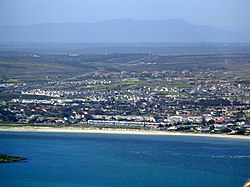Langebaan
| Langebaan | |
|---|---|

Langebaan as viewed from Postberg, West Coast National Park, with Engelsman se Baken mountains in the distance
|
|
|
|
|
| Coordinates: 33°5′30″S 18°2′0″E / 33.09167°S 18.03333°ECoordinates: 33°5′30″S 18°2′0″E / 33.09167°S 18.03333°E | |
| Country | South Africa |
| Province | Western Cape |
| District | West Coast |
| Municipality | Saldanha Bay |
| Area | |
| • Total | 20.17 km2 (7.79 sq mi) |
| Population (2011) | |
| • Total | 8,297 |
| • Density | 410/km2 (1,100/sq mi) |
| Racial makeup (2011) | |
| • Black African | 7.4% |
| • Coloured | 34.7% |
| • Indian/Asian | 0.5% |
| • White | 56.0% |
| • Other | 1.4% |
| First languages (2011) | |
| • Afrikaans | 76.2% |
| • English | 19.2% |
| • Xhosa | 1.3% |
| • Other | 3.3% |
| Postal code (street) | 7357 |
| PO box | 7357 |
| Area code | 022 |
Langebaan is a town in the Western Cape province of South Africa on the eastern shore of Langebaan Lagoon.
Langebaan is situated 120 km north of Cape Town, just off the R27, about 28 km from Vredenburg and 20 km from Saldanha Bay. The Lagoon stretches for 17 km from Saldanha Bay, past Langebaan to Geelbek in the South. In places it is up to 4 km wide.
The Langebaan Lagoon was formed by the rising and falling of sea levels during pre-historic times. This is unlike most lagoons which form where fresh water rivers enter the sea. As a result, Langebaan Lagoon is purely a salt water lagoon.
As far back as 500 000 years ago, early Homo sapiens were probably present in the area, living in groups and hunting small game, displacing carnivores, such as lions, from their kills and gathering plant foods. They made fire as protection and for cooking and probably made simple shelters from branches. They used animal skins for warmth and clothing, and also made wooden and stone tools, as evidence of these found here proofs.
The area is rich in historical events from the first inhabitants, the Khoikhoi and San, to the arrival of the Europeans. The first European to set foot on land was Vasco da Gama at St Helena Bay on the West Coast Peninsula in 1497.
António de Saldanha, after whom the bay is named, did not enter those waters at all. Juris van Spilbergen mistakenly named it in 1601 as Saldanha Bay; he thought that he had reached Cape Town – originally named Agoada de Saldanha. Although the Dutch were the first to claim ownership of the area, the French were frequent visitors.
Foreign nations would claim ownership by planting a post in the ground and formally declaring ownership. One of these ‘posts’ may be seen today near Geelbek claiming the land on behalf of the Dutch East India Company. European settlement was very limited because of the lack of water for 8 months of the year.
Many stirring events have occurred in the region over the centuries including two sea battles and a visit by the Confederate States of America’s, Alabama, in 1863, the most feared warship of its day. Even the 5 islands in the area, which are administered by the West Coast National Park, have a history of their own, including battles for ownership, use as smallpox quarantine hospitals, exploits for guano, sealing centres and other activities.
...
Wikipedia



